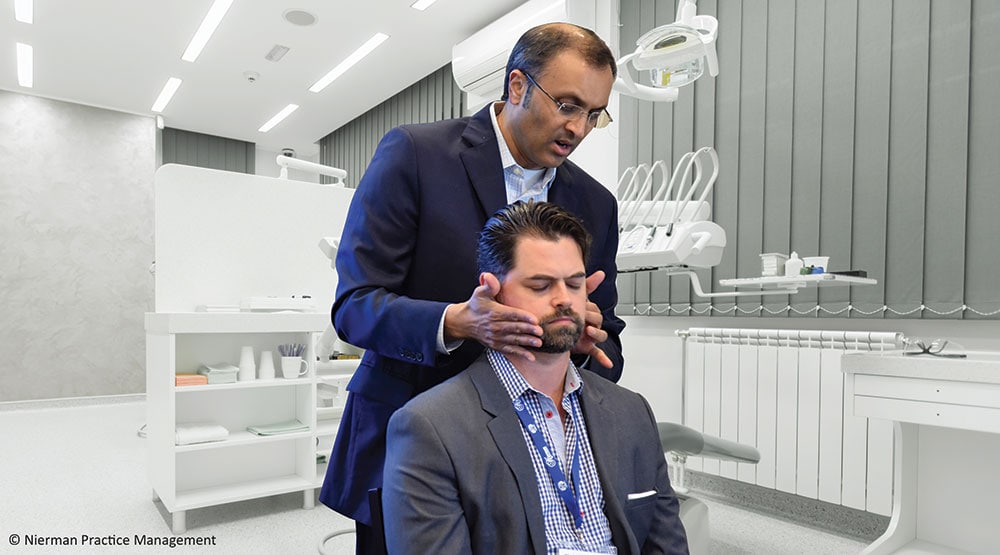by Mayoor Patel, DDS, MS
In recent years, dental devices have taken an increasingly important role in the treatment of snoring and obstructive sleep apnea (OSA). Increasing evidence suggests that mandibular advancement devices (MAD) improve sleep-disordered breathing.1
MAD is the most common class of oral appliance used to treat snoring and OSA. While there are several MAD designs, all devices protrude the mandible and induce changes in the anterior position of the tongue, soft palate, lateral pharyngeal walls, and mandible, resulting in improved airway patency.2
Response to MAD is variable and normally depends on the design and patient characteristics. The acceptance rate of MAD after one-year ranged from 55% to 82%, and there was a declining trend over time.2 The most common reasons for discontinuing MAD use are lack of efficacy, side effects, and complications.3
Side effects disrupt care
Subjective side effects are common, and the most frequently reported include temporomandibular joint (TMJ) pain, myofascial pain, tooth pain, salivation, TMJ sounds, dry mouth, gum irritation, and morning- after occlusal changes.4–7 Most of these side effects are minor, well-tolerated and tend to be resolved in a short period of time. Objective side effects such as tooth movement, skeletal changes, and occlusal alteration have also been reported.5,8–10

Temporomandibular disorders (TMD) have also been associated with the use of MAD in some patients. TMD is a cluster of heterogeneous disorders of the masticatory muscles and TMJs. The myogenous and arthrogenous disorders may be further subclassified into myofascial and arthrogenous pain, disc displacements, and degenerative joint disease as the most common conditions.
Occlusal changes in patients
Although many patients report that TMD symptoms are significantly reduced following MAD treatment, the development of some problems is not surprising, given the significant forces applied to the teeth and temporomandibular joints during jaw repositioning. In many cases, occlusal changes are minor and not noticed by the patient. This is typical because the majority of patients do not have a loss of posterior occlusion or experience TMJ pain.
Understanding the various pain conditions the patient may experience and their clinical characteristics will allow you to formulate a treatment strategy. Most pain conditions as a result of MAD are also self-limiting. Sharpening your understanding and receiving education in TMJ disorders will allow you to better manage your patients’ health and well-being.
Explore common examples
Myogenous pain over the masseter/temporalis muscle can be experienced in some patients once the appliance has been removed in the morning. This condition can be managed conservatively using temporary cessation of the MAD or reduction in the use of the device in combination with remedial jaw exercises each morning following the removal of the appliance.
Moist heat application with stretching (opening mouth and holding it for 5 seconds and repeating for a couple minutes) may also be a simple yet effective treatment option. This is considering that the mandible is not being held in an eccentric position or that heavy contacts of the posterior aspect of the appliances are not causes.
If occlusal changes are noticed upon awakening, they can, in most cases, be resolved by morning jaw exercises or ceasing MAD use for 1-2 weeks. It is important to demonstrate and have the patient show understanding of the exercises you suggest. Prevention of occlusal changes is maintained by further instruction to the patient about an ongoing exercise regimen after removal of MAD and careful monitoring by the clinician.
We consider it reasonable to persist with treatment in the presence of occlusal change, providing that it is regularly monitored (by at least 6-month clinical reviews), not associated with unacceptable symptoms, not progressive, and that there is adequate posterior occlusal support.
Further modifications and adjustments
Pain in the TMJ can be a result of capsulitis, synovitis, osteoarthritis or a variant of some form of internal derangement. Soft diet and identifying the etiology of these symptoms are critical for resolution and prevention of further pain. It is important to determine if the mandible is being held in an eccentric position or heavy contacts of the posterior aspect of the appliances are present. If so, address and make appropriate modifications to return the mandible to a more neutral position or reduce the heavy occlusion on the posterior aspect of the appliance.
In the acute stages, nonsteroidal anti-inflammatory drugs (NSAIDs), which are effective analgesics and anti-inflammatory agents, can be prescribed. Care must be taken to evaluate for gastrointestinal irritation and bleeding, which is a major risk of this class of medications.
Critically, prior to MAD therapy, completing a comprehensive screening and workup can prevent complications from arising. Many times, if a pre-existing condition is present, addressing it prior to treatment with MAD can prevent many of the symptoms experienced by patients. Many medical insurance policies now require documentation showing that there is an absence of a TMJ disorder prior to initiating oral appliance therapy so TMD screening and management becomes even more important than ever to retain insurance payments.
It is beyond the scope of this article to address all the possible treatment choices, but I do encourage you to understand the functionality of the TMJ and the various conditions that produce pain in the TMJ. Courses are available for TMD and dental sleep medicine to become familiar with the many ways you can help your patients when symptoms or side effects develop.

